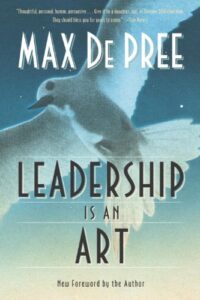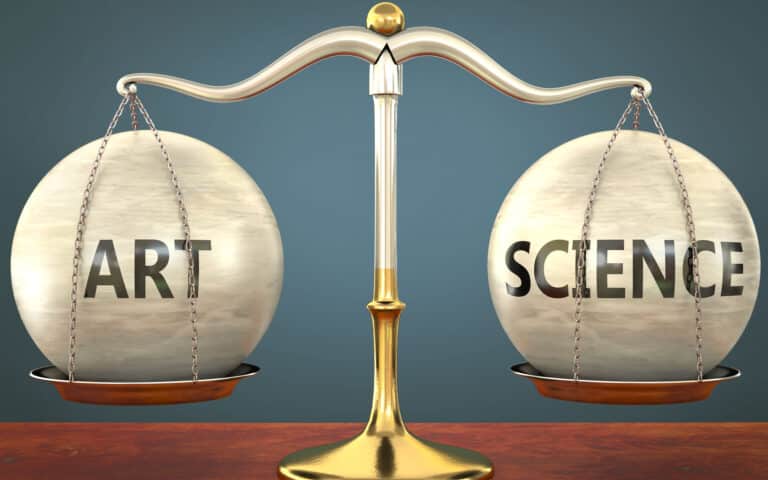Article Summary:
Is leadership an art or a science? That debate has gone on for decades. We believe it’s both—but more of an art, especially in challenging circumstances with risk and uncertainty.
+++
People have long debated whether leadership is an art of science, or both, and whether it’s more of one than another. The answer, of course, depends on how we define art and science—as well as leadership. Easier said than done. All these concepts have multiple definitions, and the way we think about and practice all of them are changing over time—and have been for a long time.
Art
Defining art is famously challenging, in part because people tend to conflate art and works of art, and in part because art can be abstract, elusive, and mystical (all part of its value and charm).
Art includes expressing or applying creative imagination and skill or ideas and feelings, often with emotional power or beauty. It stimulates our thoughts, feelings, beliefs, or ideas, typically through our senses.
People often create art to display or revere beauty, to communicate something, or to challenge or provoke people or institutions. When we think of art, we tend to think of creative activities like painting, music, dance, poetry, and literature. But we often use it in other contexts (e.g., the art of leadership, the art of negotiation, the art of the deal, even the art of war).
Science
Science also comes with many definitions and conceptualizations.
It’s the systematic study of the structure and behavior of the world through observation, experimentation, and the testing of theories using evidence. It includes the pursuit and application of knowledge. Through science, we seek to understand the natural and social world, including its fundamental properties or laws, following a systematic methodology of observing, measuring, and doing experiments. Science uses evidence—ideally, unbiased observations—at its core.
The practice of science is meant to be neutral, rigorous, and systematic. Ideally, it uncovers testable explanations and predictions about the universe.
Here we must note the different branches of science. When it comes to leadership, we’re looking at something not in the world of natural sciences (like biology, chemistry, and physics) or formal sciences (like mathematics, logic, and statistics) but in the realm of social sciences (like psychology, sociology, and economics). This gets tricky, because objective observations and repeatable experiments become more difficult as we delve into the world of people, their minds and behaviors, and their groups, teams, and organizations.
These distinctions between art and science are important, but we should be careful not to take them too far. In some ways, they intersect, as Einstein noted:
“All religions, arts, and sciences are branches of the same tree. All these aspirations are directed toward ennobling man’s life, lifting it from the sphere of mere physical existence and leading the individual towards freedom.”
-Albert Einstein, scientist
Most will agree that we want and need both art and science.

Leadership Derailers Assessment
Take this assessment to identify what’s inhibiting your leadership effectiveness. It will help you develop self-awareness and identify ways to improve your leadership.
Leadership
Leadership is also famously difficult to define. Many people don’t try and simply say they know it when they see it. (And many lament its frequent absence.) Leadership scholars Warren Bennis and Burt Nanus reported finding more than 350 definitions of leadership—and that was in the mid-1980s.
“Always, it seems, the concept of leadership eludes us or turns up in another form to taunt us again with its slipperiness and complexity. So we have invented an endless proliferation of terms to deal with it…
and still the concept is not sufficiently defined.”
-Warren Bennis, eminent leadership scholar and author
Scholar James MacGregor Burns, sometimes called the grandfather of leadership studies, once wrote:
“Leadership is one of the most observed, and least understood phenomena on Earth.”
The challenge here is its complexity. Still, there are some helpful definitions of leadership out there. For example:
“motivating people to work together to accomplish great things”
-Harvard Kennedy School
“a process whereby an individual influences a group to achieve a common goal”
-Peter G. Northouse, Leadership: Theory & Practice
Several definitions and descriptions of leadership address how it can be an art. For example:
“Leadership is the art of mobilizing others to want to struggle for shared aspirations.”
-Jim Kouzes and Barry Posner, leadership scholars and co-authors of The Leadership Challenge
“Leadership is the art of accomplishing more than the science of management says is possible.”
-Colin Powell, former U.S. Secretary of State, Army officer, and author
The plot thickens when we add management to the equation, because many people use “management” and “leadership” interchangeably, even though they’re different (albeit related). Of course, we need both good management and good leadership. A common definition of management is “the art and science of getting things done through people.”
To the question of whether leadership is art or science, we believe it’s both. We’re both longtime students, practitioners, and teachers of leadership. There’s much people can learn from research, scholarship, and evidence about effective versus ineffective leadership (and management) practices. And we’ve created our own leadership framework—“triple crown leadership”—based on extensive research, interviews with leaders around the world, and our own experience as practitioners.
We’ve also learned a great deal from other leadership frameworks—including servant, authentic, transformational, and adaptive leadership—as well as the in-depth research of scholars like Warren Bennis, Ron Riggio, Ron Heifetz, Marty Linsky, James Kouzes, Barry Posner, and others.
Recent advances in psychology, neuroscience, and other fields, including fMRI studies, are helping us understand many phenomena associated with the practice of leadership, for example: emotions, cognitive biases, heuristics, human motivations, group dynamics, influence processes, human development, team-building, culture-building, and much more. Researchers and practitioners have made advances in the assessment and development of leadership skills. And we now have big data and artificial intelligence to help us quantify, measure, and assess things related to people analytics and organizational and team performance.
So, science yes. But also art. The circumstances and people vary. Things change. In most cases, there are no set rules or formulae that leaders can use in all cases. There are evidence-based practices and helpful frameworks, yes, but no universal equations. So, as we see it, leadership is both art and science, but in many cases more art, especially in challenging circumstances with risk and uncertainty.

Personal Values Exercise
Complete this exercise to identify your personal values. It will help you develop self-awareness, including clarity about what’s most important to you in life and work, and serve as a safe harbor for you to return to when things are tough.
Max De Pree on the Art of Leadership
Perhaps the most famous formulation of leadership as an art comes from Max De Pree, who published a wonderful little book in 1987 titled Leadership Is an Art—now considered by many to be a classic in the field.

De Pree served in the Army Medical Corps during World War II, was CEO of Herman Miller (founded by his father), an award-winning and widely esteemed office furniture manufacturer. Junior Achievement inducted De Pree into its U.S. Business Hall of Fame.
In Leadership Is an Art, De Pree wrote:
“Leadership is much more an art, a belief, a condition of the heart, than a set of things to do. The visible signs of artful leadership are expressed, ultimately, in its practice.… [it’s] an art, something to be learned over time, not simply by reading books. Leadership is more tribal than scientific, more a weaving of relationships than an amassing of information.…”
As a leader in the 1960s-1980s, De Pree was far ahead of his time. He believed leaders should leave behind not only assets but a legacy, which is the “more difficult, qualitative side of life, one which provides greater meaning, more challenge, and more joy in the lives of those whom leaders enable.”
The Herman Miller company practiced participative leadership. All workers were stockholders within a year of employment. De Pree praised the company’s “roving leaders” who stepped up to lead even without title or authority whenever circumstances demanded. He believed companies should have not just contractual arrangements with workers but also “covenantal arrangements” involving “shared commitments with grace, warmth, unity, poise, and love.”
Leadership Is Complex
Leadership is complex, with many nuances. It’s not mechanistic nor always logical. Besides the people involved (addressed below), good leadership accounts for the circumstances leaders find their organizations in.
Was there one right way for General George Patton and Mahatma Gandhi to lead that would have worked for both? For Washington and Lincoln? Or for Martin Luther King, Jr. and Nelson Mandela? For Christine Lagarde at the European Central Bank and Volodymyr Zelenskyy in Ukraine? Or for Mary Barra at General Motors and Satya Nadella at Microsoft?
The demands of leadership in a startup are different from those of a steady-state organization or one going through a rapid scale-up or radical transformation or crisis.
Leadership Art and Science in Practice
It’s in its practice in different areas that we can see how leadership is both art and science. We address this briefly below in the areas of people, vision, culture, and alignment.
The Art and Science of Leading People:
Leadership involves motivating, inspiring, directing, developing, and unleashing people, with all their gifts, talents, emotions, hopes, fears, dreams, and imperfections. How many times have we heard that “this organization would be great if it weren’t for all the people issues”?
Every organizational effort involves people, stakeholders, and relationships among them. Such relationships can be exceedingly complex, requiring a range of different management and leadership approaches, from knowing when to lead, manage, or follow to deciding when to use “steel” or “velvet” (the hard and soft edges of leadership), and much more. Addressing such people matters is an art likely never completely mastered but learnable over time.
“When we think about leaders and the variety of gifts people bring to corporations and institutions, we see that the art of leadership lies in polishing and liberating and enabling those gifts…. The art of leadership is liberating people to do what is required of them in the most effective and humane way possible.” -Max De Pree, Leadership Is an Art
The Artistry of Vision:
Bob Whipple, an expert on leadership and trust, notes that creating a vision is an important part of the artistry of leadership. He wrote that by painting a vivid word picture of a vision for an improved organization:
“…leaders create optimism and enthusiasm. People can see for themselves how the world they will experience is better than the one they have. That realization creates a sense of excitement that helps the organization reach its vision. Leaders become the artists who carefully paint the picture of a better future on the canvas of today’s paradigm.”
The Art and Science of Culture-Building:
Building culture is a critical aspect of leadership because other important elements of an organization—like strategy, business model, and operations—depend on the culture for their execution. Even a great strategy will likely fail in a poor culture. Leaders must create great systems and processes to build the culture (the science of building culture), but they also need to listen, learn, adapt, empower, and unleash (the art of building culture).
The Art and Science of Alignment:
Alignment is a collaborative process (involving both leadership and management) that provides cohesion, clarity, and focus to get everyone moving in the same direction. Most leaders sense alignment is important but struggle with doing it well (and often enough). Where to start in the alignment process depends on where the organization is at the time, a matter of leadership experience and judgment.
Alignment requires work at all the levels of an organization and should flow in all directions, including top-down, middle-level-out, and bottom-up. This requires good systems and processes and extensive, multidirectional communication (the science of it). At the same time, alignment requires the artistry of deep listening and dialogue, not just edicts from the top, and synthesis of the inputs and themes. It takes time for ideas to simmer, for feedback to percolate from all parts of the organization, and for consensus and commitment to develop, with the leader drawing on her own intuition and counsel from trusted advisors.

Alignment Scorecard
When organizations aren’t aligned, it can reduce performance dramatically and cause frustration and dysfunction. With this Alignment Scorecard, you can assess your organization’s level of alignment and make plans for improving it.
The Artistry of Fostering Creative Teams and Organizations:
Good leaders foster innovation in their organizations to make sure they can win the future, not just the present. To do that, they must elicit and foster the creativity of their people and teams. Ideally, they build an “ambidextrous organization” that’s good both at the efficient implementation of their current business model but also at innovation and the search for new business models for the future. To do this, they can employ skunkworks or tiger teams. There’s much artistry involved in the orchestration and development of these skills and flexible approaches.
What Inhibits Leadership Artistry
As you seek to enhance the artistry of your leadership, here are ten things to watch out for or avoid:
- being stuck in a rigid leadership paradigm or mental model
- needing to be in charge and control (a sign of insecurity)
- jumping to the first, most obvious, or most conventional idea or solution
- not understanding the context clearly or deeply
- being too thin-skinned to welcome criticism and tough feedback
- having colleagues who lack the courage to speak up
- having an organizational culture that lacks diversity and psychological safety
- moving too quickly and thereby missing important steps or signals
- moving too slowly and being indecisive
- having a rigid culture that operates in silos
What else inhibits the artistry of your leadership?
How to Bring More Artistry to Your Leadership
Our own experiences in large and small organizations, public and private, for-profit and non-profit, have shown us some ways to add more artistry to our leadership:
- reading and learning about the experiences of great leaders, teams, and organizations
- being your authentic self
- developing your leadership skills by continually volunteering for more leadership opportunities
- setting your own personal values and moral compass
- never failing to act with integrity
- ensuring your organization or team has a shared purpose, values, and vision that everyone understands and commits to supporting
- synthesizing the complexity of issues your organization faces and finding the “simplicity on the other side of complexity”
- believing in the inherent capabilities of your colleagues—and showing them that belief often
- approaching people and circumstances with an open mind, growth mindset, and genuine desire for meaningful input from others
- asking lots of questions
- unleashing people to experiment, innovate, and lead and letting them achieve objectives their way, guided by your gentle coaching
- creating an innovative, high-performance culture where it’s safe to express diverse, novel, and bold ideas
What else can you do to enhance the artistry of your leadership?
Reflection Questions
- What are your thoughts on leadership as an art, science, or both?
- In which areas are you excelling, and in which areas could you improve?
- What will you do to develop the artistry of your leadership even further?
Tools for You
- Leadership Derailers Assessment to help you identify what’s inhibiting your leadership effectiveness
- Personal Values Exercise to help you determine and clarify what’s most important to you
- Alignment Scorecard to help you assess your organization’s level of alignment
Related Articles
Postscript: Quotations on the Art and Science of Leadership
- “The first responsibility of a leader is to define reality. The last is to say thank you. In between the two, the leader must become a servant and debtor. That sums up the progress of an artful leader.” -Max De Pree, Leadership Is an Art
- “Most will say that leadership is more art than science and will always be an art form—profoundly successful leadership being rare and confined to unusual people in unusual circumstances. This romantic view of leadership is like the view of disease before the invention of the microscope and penicillin.” -Lynne Ellyn, former Senior VP and CIO at DTE Energy, Cuter Consortium Fellow
- “The art of leadership dwells a good deal in the future, in providing for the future of the organization, in planting and growing other leaders who will look to the future beyond their own.” Max De Pree, Leadership Is an Art

Triple Crown Leadership Newsletter
Join our community. Sign up now and get our monthly inspirations (new articles, announcements, opportunities, resources, and more). Welcome!
+++++++++++++++++++++++
Gregg Vanourek and Bob Vanourek are leadership practitioners, teachers, and award-winning authors (and son and father). They are co-authors of Triple Crown Leadership: Building Excellent, Ethical, and Enduring Organizations, a winner of the International Book Awards. Check out their Leadership Derailers Assessment or get their monthly newsletter. If you found value in this, please forward it to a friend. Every little bit helps!


2 thoughts on “Leadership as Art and Science—But More Art”
Article is simply amazing. It is worth reading.
Thanks for letting us know, Rajendra, and so glad to hear you found value in this article.